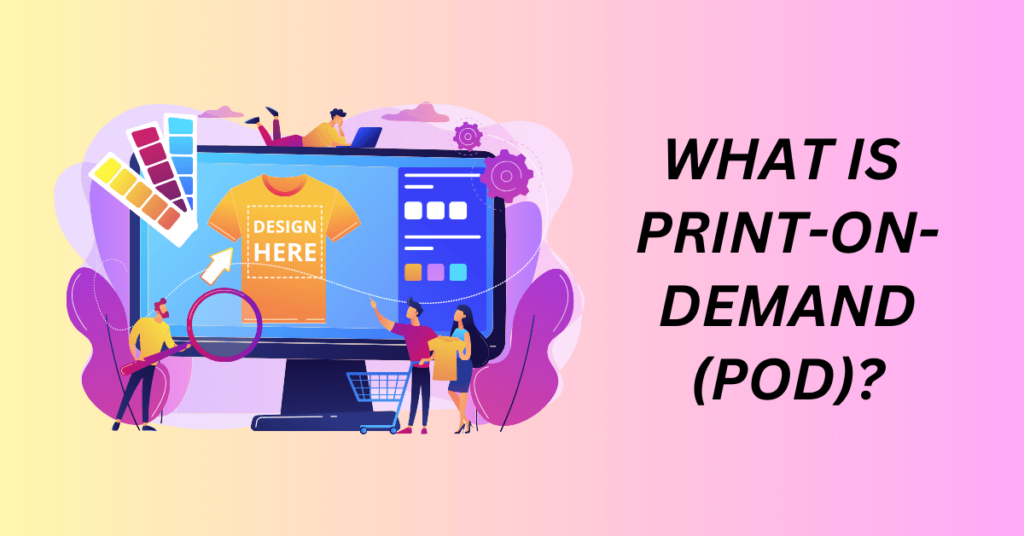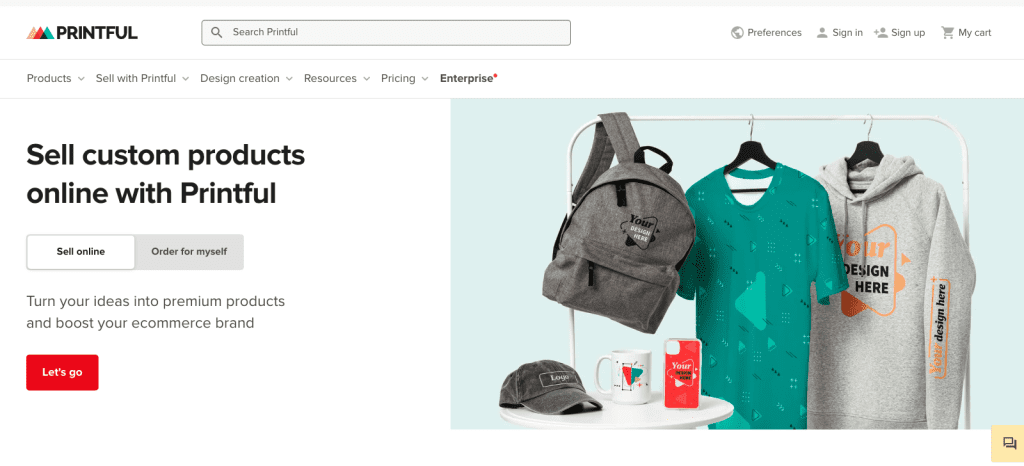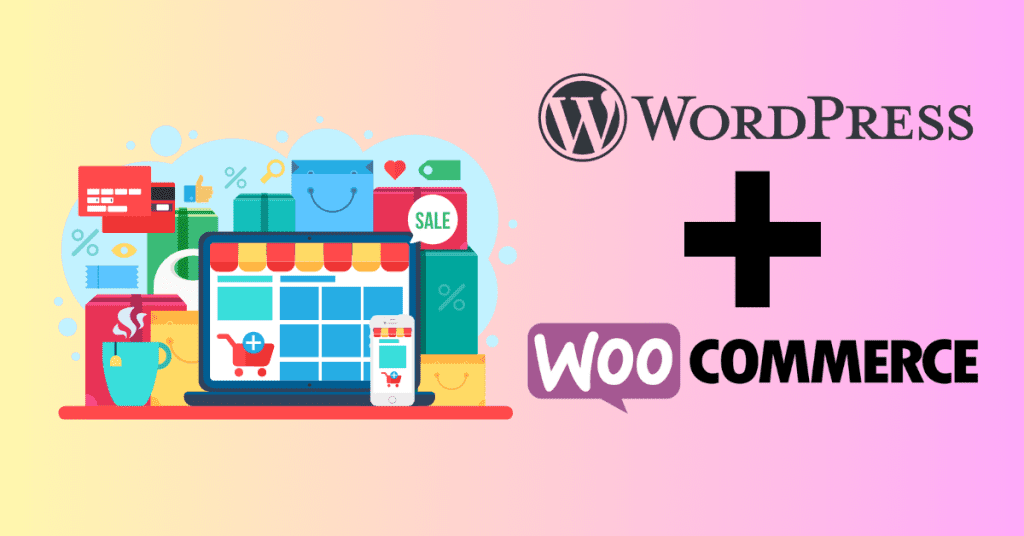In recent years, the landscape of online retail has witnessed a significant shift, and print-on-demand (POD) has emerged as a revolutionary concept that is transforming how products are designed, produced, and delivered to consumers. If you’re intrigued by the idea of running an online store without the need for massive inventory or hefty upfront investments, you’re in the right place.
Whether you’re a creative artist, an aspiring entrepreneur, or an established business looking to expand, understanding print-on-demand can open up exciting opportunities. From personalized apparel and custom home decor to unique accessories and beyond, print-on-demand empowers you to showcase your creativity and cater to niche markets.
In this blog, we will explain the fundamentals of print-on-demand e-commerce, exploring its ins and outs, benefits, best practices, and how to kickstart your own successful venture in this dynamic and innovative industry.
Start Your Print-On-Demand Store with Shopify
What is Print-On-Demand (POD)?

Print on demand (POD) is a modern publishing and manufacturing process in which books, apparel, or other products are created on an as-needed basis, in response to specific customer orders.
Unlike traditional publishing or manufacturing methods that require producing a predetermined quantity of items in advance, POD allows for individual items to be produced and shipped only when they are ordered. This approach minimizes the need for excess inventory and reduces the risks and costs associated with unsold merchandise.
In essence, POD offers a more efficient and sustainable way to produce and distribute products to meet consumer demand.
In the context of book publishing, POD involves printing a book when a customer places an order, typically through an online platform or a retailer. The printing process utilizes digital printing technology, allowing for cost-effective and high-quality production of single copies or small print runs.
This model benefits both publishers and authors, as it allows for the publication of books with lower upfront costs and eliminates the need for large print runs, warehousing, and the associated risks of overstocking. Moreover, it enables authors to easily distribute their work to a global audience without the hurdles of traditional distribution channels.
The benefits of print-on-demand extend beyond books and literature. In fact, it has been embraced by the apparel industry, where clothing items and accessories can be produced on demand based on specific designs or patterns.
This approach reduces waste, enables customization, and offers a more sustainable alternative to mass production. Hence, consumers can choose and personalize products to match their preferences, contributing to a more personalized and eco-friendly shopping experience.
Overall, print-on-demand revolutionizes the way products are made, allowing for greater efficiency, reduced waste, and a more customer-centric approach to production and distribution.
Start Your Print-On-Demand Store with Shopify
The Pros and Cons of Print-On-Demand for Your Ecommerce Business

While this model offers considerable advantages, it’s essential to weigh the pros and cons before integrating print-on-demand into your ecommerce strategy.
Pros of Print-on-Demand
1. Low Initial Investment
One of the most appealing aspects of print-on-demand is the low upfront costs. In contrast, traditional retail models often require significant investment in inventory, warehousing, and manufacturing. With POD, you can start with minimal capital as you only produce items as they are ordered.
2. No Inventory Risk
Print-on-demand eliminates the risk associated with holding excess inventory. Since you only create products after receiving orders, you won’t be left with unsold items that tie up your finances and storage space.
3. Product Diversification
POD allows you to offer a wide array of products without the burden of maintaining a vast inventory. From clothing and accessories to home decor and stationery, you can experiment with various product categories to find what resonates best with your audience.
4. Flexibility and Scalability
As your business grows, you can easily scale your operations without worrying about production limitations. POD platforms can handle increased order volumes, enabling your business to expand seamlessly.
5. Customization and Personalization
Customers appreciate personalized products. Hence, Print-on-demand enables you to offer customization options. This will allow buyers to tailor items according to their preferences. This personal touch often leads to higher customer satisfaction and repeat purchases.
6. Reduced Time to Market
Traditional manufacturing can be time-consuming, involving production cycles that span weeks or months. On the contrary, print-on-demand allows you to bring products to market quickly, giving you a competitive edge in the fast-paced ecommerce landscape.
Cons of Print-on-Demand
1. Lower Profit Margins
Due to the convenience and reduced risk associated with print-on-demand, profit margins are often lower compared to traditional retail models. The costs of printing and fulfilment can eat into your profits, requiring strategic pricing to maintain a viable business.
2. Limited Quality Control
Since you don’t handle the production process directly, maintaining consistent quality can be a challenge. Your reputation relies on the performance of your print-on-demand partner, so it’s crucial to choose a reliable and reputable provider.
3. Dependence on Third-Party Suppliers
Your business’s success is partially dependent on the performance and reliability of the print-on-demand partner. If they face any production issues or delays, it can impact their ability to fulfil customer orders in a timely manner, potentially leading to customer dissatisfaction.
4. Design Constraints
Print-on-demand often comes with specific design and printing limitations. Understanding these constraints and ensuring your designs adhere to them is essential to maintaining a seamless production process.
5. Shipping Costs and Times
Shipping costs and delivery times can vary based on the print-on-demand provider and the location of your customers. This can affect customer expectations and satisfaction, especially if they are accustomed to faster shipping times.
6. Lack of Control Over Inventory
Since you don’t manage your own inventory, you may face challenges during peak seasons or promotional events when demand surges. Balancing supply and demand becomes a delicate task, and relying solely on a third party can sometimes limit your control.
Start Your Print-On-Demand Store with Shopify
Best Print-On-Demand Service Providers

There are many different print-on-demand suppliers out there offering similar products and services. However, when you research carefully, they are all different.
It can be the price, processing time, shipping time, quality of the product, manufacturing method and other factors. Since you are not going to touch and handle the product yourself, it is very important that you get a reliable supplier.
Below are two famous print-on-demand suppliers that we use:
1. Printful – Print-On-Demand Service Provider

Printful is a popular and widely used print-on-demand (POD) and dropshipping platform. In addition, it offers a comprehensive range of custom printing and fulfilment services. Furthermore, it allows individuals, businesses, and online retailers to create and sell their own custom-designed products without the need for upfront investment in equipment, inventory, or warehousing.
Printful integrates with various ecommerce platforms. This includes platforms such as Shopify, WooCommerce, Etsy, and more. Hence, providing a seamless and automated process from order placement to product delivery.
With Printful, you can easily design and upload your artwork onto a wide array of products. This includes apparel, accessories, home decor, and promotional items. The platform handles the printing, packing, and shipping of products directly to customers on your behalf, saving you time and resources.
Additionally, Printful offers branding options like custom labels and packing slips. This allows businesses to maintain a consistent and professional brand image. In addition, the user-friendly interface, competitive pricing, and high-quality printing make Printful a preferred choice for individuals and businesses looking to start or expand their ecommerce ventures without the complexities of traditional manufacturing and fulfillment processes.
2. Printify – Print-On-Demand Service Provider

Printify is a leading print-on-demand (POD) platform that empowers individuals and businesses to design, sell, and fulfil custom products with ease. Similar to other POD services, Printify eliminates the need for inventory and upfront production costs. Additionally, it integrates seamlessly with popular ecommerce platforms like Shopify, WooCommerce, Etsy, and more
This allows you to create your own online stores and start selling your personalized designs on a wide range of items, from apparel to home decor.
On the Printify platform, you can choose from a vast selection of customizable products and upload your artwork or designs onto them. The easy-to-use design interface enables customization of designs and placement on the chosen products.
Once an order is placed, Printify’s network of printing partners, located across the globe, produces the item and ships it directly to the customer. This global network enables faster shipping times and lower shipping costs, enhancing the overall customer experience.
Printify’s user-friendly interface, automated order fulfilment, competitive pricing, and extensive product options have made it a popular choice for individuals and businesses seeking to launch their online stores with minimal overhead and maximum flexibility.
How to Create Your Design for Print-on-Demand Even if You’re Not a Designer

Print-on-demand (POD) has revolutionized the way we approach ecommerce. It allows entrepreneurs to design and sell customized products without the need for advanced design skills or a background in graphic design.
If you’re not a designer but want to create compelling designs for your print-on-demand business, fret not! Here are some accessible and user-friendly methods to help you unleash your creativity and design unique products.
1. Use Online Design Tools:
Several online platforms provide user-friendly design tools that allow you to create custom designs without any prior design experience. These tools often come with pre-designed templates and a wide range of elements like shapes, text styles, and images that you can easily manipulate and combine to craft your design.
Some popular online design tools include:
2. Leverage Free Stock Images:
Not everyone has access to a personal library of high-resolution images. Fortunately, there are numerous websites offering free stock images that you can use for your designs. Free stock images are those that you can use without worrying about the copyright infringement issue.
Websites like Unsplash, Pexels, and Pixabay offer an extensive collection of images that can serve as a great starting point for your design.
3. Utilize Graphics and Icons:
Simple graphics and icons can be powerful design elements that require little to no artistic skills. Incorporating icons related to your theme or product can add visual appeal to your designs.
Websites like Flaticon and Iconfinder offer an extensive collection of icons suitable for various themes.
4. Experiment with Typography:
Typography is an art form in itself and can greatly enhance your design. Experiment with different fonts, sizes, and styles to create eye-catching text-based designs. Websites like Google Fonts and Adobe Fonts offer a wide range of fonts that you can use for free.
If you check on other marketplaces, you can find lots of print-on-demand products with simple font only. Take those as free inspiration for you to start.
5. Collaborate with Freelance Designers:
If you have a specific design in mind but lack the skills to create it, consider collaborating with a freelance designer. Platforms like Fiverr and Upwork allow you to connect with skilled designers who can bring your vision to life at an affordable cost.
6. Understand Your Audience and Niche:
Before you start designing, take the time to understand your target audience and niche. Research what appeals to them and tailor your designs accordingly. This understanding will guide your design choices and help you create designs that resonate with your potential customers.
In short, you don’t need to be a professional designer to create captivating designs for your print-on-demand business. With the abundance of online tools, free resources, and a little creativity, you can produce designs that resonate with your audience.
Start Your Print-On-Demand Store with Shopify
Tips for Starting with Print-On-Demand

Tip 1: Conduct Market Research and Choose a Niche – Print-on-Demand
Market research is the cornerstone of a successful print-on-demand venture. Before diving in, conduct thorough research to comprehend market trends, consumer preferences, and emerging niches. Identify what’s popular and in demand, but also consider your interests and passions.
Striking a balance between market demand and your personal affinity for a niche is key. Analyze competitors, consumer behaviours, and the potential for growth in your chosen niche. This research will serve as the foundation for creating and marketing products that resonate with your target audience.
Selecting the right niche is equally crucial. The niche you choose should align with your interests, making it easier for you to stay motivated and enthusiastic about your business. It’s advisable to choose a niche that you are genuinely passionate about, as it can help you stay committed during challenging times. Moreover, consider the profitability and sustainability of the niche.
Assess the market’s long-term potential and evaluate whether the niche allows for product diversification, ensuring your business can adapt and evolve over time. Once you’ve conducted a thorough analysis, you’ll be better equipped to make an informed decision about the niche that aligns with your goals and interests.
Tip 2: Select the Ideal Print-on-Demand Platform – Print-on-Demand
Choosing the right print-on-demand platform is a pivotal decision in launching your business. Evaluate various platforms based on a set of criteria such as product offerings, ease of use, pricing, printing quality, and customer support. Assess the variety of products each platform offers, ensuring they align with your intended product range.
Look for a user-friendly interface and easy integration with popular ecommerce platforms like Shopify, WooCommerce, or Etsy. Pricing is a critical factor; understand the platform’s pricing structure, including base costs, printing fees, and any additional charges.
Additionally, prioritize printing quality. Investigate the printing methods used by each platform, such as direct-to-garment, sublimation, or screen printing, and choose a platform that aligns with your quality standards.
Customer support is vital for resolving potential issues promptly. Read reviews, seek recommendations, and even reach out to the platform’s support to gauge their responsiveness and helpfulness.
Selecting a reliable and efficient print-on-demand platform lays the groundwork for a successful business, ensuring smooth operations and satisfied customers.
Tip 3: Understand Printing Options and Quality – Print-on-Demand
Delving into the specifics of printing is crucial for delivering high-quality products to your customers. Different printing methods have distinct characteristics that can significantly impact the final product. Direct-to-garment (DTG) printing, for instance, provides a detailed and vibrant print suitable for intricate designs.
On the other hand, sublimation offers a more permanent and seamless integration of the design with the fabric, making it ideal for all-over prints. Understanding these methods allows you to choose the most suitable one for your designs and products.
Equally important is prioritizing printing quality to ensure customer satisfaction. Request samples from your chosen print-on-demand provider to assess the actual print quality on different materials.
Analyze factors such as colour vibrancy, durability, and how well the print withstands washing. Your customers will associate the quality of the print with your brand, so investing in top-notch printing ensures a positive perception and encourages repeat purchases.
Tip 4: Create Unique and Compelling Designs – Print-on-Demand
Designs are the heart and soul of your print-on-demand business. Even without formal design training, you can create captivating designs using various online design tools. Familiarize yourself with these tools and leverage their templates, elements, and customization options to craft unique designs that align with your chosen niche.
Tailor your designs to cater to the preferences and interests of your target audience. Strive for originality, creativity, and visual appeal to set your products apart in a competitive market. Remember, your designs reflect your brand, so investing time and effort into creating compelling visuals is a worthwhile endeavour.
Moreover, consider seeking inspiration from various sources, such as social media, design communities, or art exhibitions. Analyze trending designs within your niche and identify elements that resonate with your audience. Incorporate these insights into your creations while adding your unique touch.
Experiment with different styles, colour schemes, and visual elements to find a design aesthetic that appeals to your target market. Continuous improvement and innovation in your designs will help keep your product line fresh and engaging for your customers.
Tip 5: Offer Product Personalization – Print-on-Demand
One of the key strategies to enhance customer engagement and boost sales in the print-on-demand model is offering product personalization. In fact, consumers appreciate products that reflect their individuality and preferences. Hence, you can provide options for customization, allowing customers to add their names, special dates, or unique messages to your products.
This personal touch transforms a standard item into a meaningful and cherished possession for your customers, encouraging them to make a purchase.
Integrating a user-friendly interface on your ecommerce platform that facilitates personalization is essential. Make the customization process intuitive, allowing customers to preview their personalized design before making a decision.
Offering product personalization not only adds value to your products but also provides a delightful shopping experience, fostering customer loyalty and advocacy. As you establish a reputation for personalized, unique offerings, word-of-mouth referrals and repeat purchases are likely to increase.
Tip 6: Develop a Sound Pricing Strategy – Print-on-Demand
Determining the right pricing strategy is a delicate balance between covering your costs, ensuring profitability, and setting a competitive price in the market. Firstly, start by calculating the total cost per product, including production, platform fees, shipping, and marketing costs.
Factor in a reasonable profit margin that justifies your efforts and investments. Additionally, research competitor pricing within your niche to gauge market expectations and align your prices accordingly.
Consider dynamic pricing strategies, especially during promotions or sales events, to drive sales and attract price-sensitive customers. Bundling products or offering discounts for bulk purchases can also incentivize customers to buy more.
Finally, review and adjust your pricing strategy regularly based on customer feedback, sales data, and changing market trends to maintain a competitive edge and sustain profitability. A well-considered pricing strategy is fundamental to the success and sustainability of your print-on-demand business.
Tip 7: Optimize Your Online Store – Print-on-Demand
Your online store is the virtual face of your print-on-demand business, and optimizing it is crucial for a successful venture. Firstly, start by selecting a user-friendly ecommerce platform that aligns with your needs and integrates well with your chosen print-on-demand provider.
Customize your store’s design to match your brand identity, incorporating high-quality images, an intuitive layout, and a seamless shopping experience.
Then, ensure that your product listings are optimized with compelling product descriptions, high-resolution images, and relevant keywords. The visuals and information you provide should accurately represent your products and entice potential buyers.
Implement effective categorization and navigation to help visitors easily find what they’re looking for, ultimately leading to higher conversions and improved user satisfaction.
Moreover, prioritize a secure and smooth checkout process to minimize cart abandonment. Implement trust signals, such as secure payment gateways and customer reviews, to instil confidence in your buyers. Regularly monitor website performance, loading times, and user behaviour to identify areas for improvement and optimize your online store for maximum visibility and sales.
Tip 8: Integrate Marketing Efforts – Print-on-Demand
Marketing is the lifeblood of any ecommerce business, and integrating various marketing strategies is essential to promote your print-on-demand products effectively. Leverage social media platforms to showcase your products, engage with your audience, and build a community around your brand.
Then, utilize email marketing campaigns to keep your customers informed about new product launches, promotions, and updates.
In addition, collaborate with influencers and bloggers within your niche to reach a broader audience and gain credibility. Furthermore, running targeted advertising campaigns through platforms like Facebook, Instagram, or Google Ads allows you to reach potential customers based on their interests, behaviour, and demographics.
Implement search engine optimization (SEO) strategies to improve your online store’s visibility in search engine results, driving organic traffic to your site.
Finally, consistency and a cohesive brand message across all marketing channels are key. Analyze the performance of your marketing efforts using analytics tools to refine your strategies and optimize your budget allocation for maximum impact.
A well-executed and integrated marketing approach will drive traffic, increase brand awareness, and ultimately lead to higher sales and growth for your print-on-demand business.
Tip 9: Prioritize Excellent Customer Service – Print-on-Demand
Providing exceptional customer service is a foundational element for any successful print-on-demand business. Timely and helpful responses to customer inquiries, concerns, or issues can make a significant difference in customer satisfaction and brand perception.
Implement clear communication channels, such as email, live chat, or a dedicated customer support line, to ensure customers can reach out easily.
Firstly, train your support team, if applicable, to handle customer interactions professionally and efficiently. Then, address and resolve concerns promptly, demonstrating your commitment to delivering a positive shopping experience. Offering hassle-free returns, exchanges, or refunds when necessary also contributes to building trust and credibility with your customer base.
Finally, incorporate customer feedback mechanisms to gather insights and opinions about your products and services. Actively listen to customer suggestions and complaints, and use this feedback to make informed business decisions and improvements.
A satisfied customer is more likely to become a repeat customer and may even advocate for your brand, contributing to organic growth through referrals and positive reviews.
Tip 10: Analyze and Optimize Your Strategies – Print-on-Demand
In the dynamic world of ecommerce, continuous analysis and optimization are paramount for success. Regularly analyze various aspects of your print-on-demand business, including sales data, website traffic, conversion rates, and customer behaviour.
Identify trends, patterns, and areas for improvement to make informed decisions and optimize your strategies accordingly.
Leverage analytics tools to track the performance of your marketing efforts, providing valuable insights into what works and what doesn’t. Adjust your marketing strategies, product offerings, and pricing based on data-driven decisions to maximize profitability and customer engagement. Implement A/B testing to experiment with different approaches and determine what resonates best with your audience.
Stay informed about industry trends, new technologies, and emerging ecommerce platforms to adapt and evolve your business model. Continuously seek ways to innovate and enhance your products, services, and customer experience. Adapting to changing consumer preferences and market dynamics is key to sustaining a competitive edge and achieving long-term success in the print-on-demand industry.
Tip 11: Consider Legal and Compliance Aspects – Print-on-Demand
Navigating the legal and compliance landscape is a critical aspect of running a print-on-demand business. Ensure your designs and products comply with copyright and trademark laws to avoid legal complications.
Avoid using copyrighted material without proper licensing or authorization, as this could lead to legal action against your business.
Consider consulting with legal professionals or intellectual property experts to guide you through compliance requirements and protect your business interests. It’s better to invest in legal counsel upfront to avoid potential legal disputes in the future. Additionally, familiarize yourself with consumer protection laws and regulations to ensure your business practices align with legal standards and industry norms.
Regularly review and update your terms of service, privacy policy, and other legal documents to reflect any changes in your business operations or regulations. Being proactive about legal compliance not only protects your business but also establishes trust and credibility with your customers, contributing to the long-term success of your print-on-demand venture.
Start Your Print-On-Demand Store with Shopify
Final Thoughts – Start Your Print-On-Demand Store Today
Starting a print-on-demand business can be an exciting and lucrative endeavour with the right strategies in place. Each of these tips provides essential guidance to help you kickstart your print-on-demand journey.
Success in print-on-demand requires a combination of creativity, market understanding, excellent customer service, and legal compliance. By integrating these tips and continuously refining your approach, you’ll be on your way to building a successful and sustainable print-on-demand business.
Good luck on your entrepreneurial journey! Start now and don’t wait.





